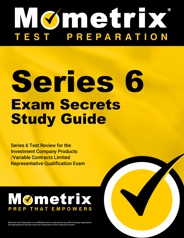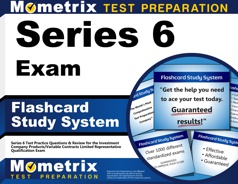The Series 6 exam, also called the Investment Company and Variable Contracts Products Representative exam, is administered by FINRA for individuals who wish to obtain a series 6 license to become a representative.
Click “Start Test” above to take a free Series 6 practice test!
Series 6 Exam Eligibility
To be eligible to take the Series 6 exam, you must be associated with and sponsored by a FINRAFINRA is the Financial Industry Regulatory Authority. This organization is a private corporation designed to protect investors by keeping the United States securities industry operating fairly and honestly. Part of keeping the securities industry running fairly is ensuring that everyone who sells securities products is tested, qualified, and licensed. member firm or another self-regulatory organization member firm.
Series 6 Exam Outline
The Series 6 exam contains 55 multiple-choice questions, five of which are unscored, and you will be given a time limit of 1.5 hours.
The exam is split into four major job functions:
1. Seeks Business for the Broker-Dealer from Customers and Potential Customers
The 12 scored questions under this function assess your ability to contact current and potential customers using various methods of communication as necessary, develop seek approval to distribute advertising materials, and describe investment services to customers with the intent of soliciting business.
These are the FINRA rules you must be familiar with for this section:
- 2210: Communications with the public
- 2211: Communications with the public about variable life insurance and variable annuities
- 2212: Use of investment companies rankings in retail communications
- 2213: Requirements for the use of bond mutual fund volatility ratings
- 2330: Members’ responsibilities regarding deferred variable annuities
- 3160: Networking arrangements between members and financial institutions
- 3170: Tape recording of registered persons by certain firms
2. Opens Accounts After Obtaining and Evaluating Customers’ Financial Profile and Investment Objectives
The eight scored questions under this function assess your ability to inform customer of the types of accounts, provide disclosures about various account types, obtain and update customer information, make an effort to obtain customer investment profile information, and obtain supervisory approval to open accounts.
These are the FINRA rules you must be familiar with for this section:
- 2090: Know your customer
- 2111: Suitability
- 2214: Requirements for the use of investment analysis tools
- 3110: Supervision
- 3120: Supervisory control system
- 3260: Discretionary accounts
- 4512: Customer account information
- 4514: Authorization records for negotiable instruments drawn from a customer’s account
- 4515: Approval and documentation of changes in account name or designation
3. Provides Customers with Information About Investments, Makes Recommendations, Transfers Assets, and Maintains Appropriate Records
The 25 scored questions under this function assess your ability to provide customers with investment strategy information, review and analyze customer investment profiles and product options, provide the required disclosures pertaining to investment products, and communicate with customers about their contact information and process requests.
These are the FINRA rules you must be familiar with for this section:
- 2165: Financial exploitation of specified adults
- 2231: Customer account statements
- 2232: Customer confirmations
- 2273: Educational communication related to recruitment practices and account transfers
- 2320: Variable contracts of an insurance company
- 2341: Investment company securities
- 4510: Books and records requirements
- 11870: Customer account transfer contracts
4. Obtains and Verifies Customers’ Purchase and Sales Instructions and Agreements; Processes, Completes, and Confirms Transactions
The five scored questions under this function assess your ability to provide current quotes, process and confirm customer transactions, identify discrepancies and errors, resolve disputes and complaints, and address margin issues.
These are the FINRA rules you must be familiar with for this section:
- 4513: Records of written customer complaints
- 4530: Reporting requirements
- 5310: Best execution and interpositioning
- 5330: Adjustment of orders
- 6140: Other trading practices
- 8000 Series: Investigations and sanctions
- 11000 Series: Uniform practice code
- 12000 Series: Code of arbitration procedure for customer disputes
- 13000 Series: Code of arbitration procedure for industry disputes
- 14000 Series: Code of mediation procedure
Check Out Mometrix's Series 6 Study Guide
Get practice questions, video tutorials, and detailed study lessons
Get Your Study Guide
Registration
You will need to be registered with FINRA via the Central Registration Depository (CRD) Program to be able to take the Series 6 exam. The firm you are connected with will handle this process. An examination fee of $75 is due at the time of registration.
How to Study
Think you aren’t a good test-taker? Maybe on a study-time crunch? Or just don’t know how to begin studying? Mometrix has designed a new Study Secrets course to help every student, no matter what study scenario you are in. Here’s what you’ll find in the Study Secrets Course:
- Techniques to Conquer Procrastination
- Steps to building a Study Plan custom to your learning style
- 7 Effective Note-Taking Methods
- Test-Taking Tips
- Memory Techniques and Mnemonics
- And much more!
Everyone learns differently, so we’ve tailored our Study Secrets Course to ensure every learner has what they need to prepare for their upcoming exam or semester. Click below to check it out!
Test Day
In-person Testing
You should arrive at the testing center at least 15 minutes before the exam is scheduled to begin. If you arrive late, you will not be permitted to sit for the exam. Once you arrive, you will be asked to show a valid, government-issued photo ID.
Once the check-in process is complete, you will be asked to leave all personal items in a secure locker, such as your cell phone, papers, notebooks, food, jacket, and hat.
Once the exam begins, you are permitted to take breaks, but the timer will not be stopped while you are away.
Remote Testing
You should check the compatibility of your computer’s audio, video, and webcam before the day of the exam. You will need to download and install an application that will perform a system check to ensure your laptop or desktop operating system meets the minimum requirements.
On the day of your exam, ensure that your testing area is clear of personal items, such as your cell phone, reference materials, scratch paper, and food or drink containers. Also be sure that you can move the webcam around for the proctor so they can view your area.
You can launch the examination up to 30 minutes before your scheduled appointment. You cannot leave the webcam’s view during your exam, use other monitors, or talk to anyone. If the proctor observes questionable behavior, your exam will be canceled.
How the Exam is Scored
The Series 6 exam is scored using the modified-Angoff method, which means that your final score is determined based only on your performance on the examination. Each version of the exam is different, so the number of correct responses needed to obtain a passing score will vary slightly.
A passing score for this exam is 70%.
Check Out Mometrix's Series 6 Flashcards
Get complex subjects broken down into easily understandable concepts
Get Your Flashcards
How to Study Effectively
Your success on Series 6 test day depends not only on how many hours you put into preparing but also on whether you prepared the right way. It’s good to check along the way to see whether your studying is paying off. One of the most effective ways to do this is by taking Series 6 practice tests to evaluate your progress. Practice tests are useful because they show exactly where you need to improve. Every time you take a free Series 6 exam practice test, pay special attention to these three groups of questions:
- The questions you got wrong
- The ones you had to guess on, even if you guessed right
- The ones you found difficult or slow to work through
This will show you exactly what your weak areas are and where you need to devote more study time. Ask yourself why each of these questions gave you trouble. Was it because you didn’t understand the material? Was it because you didn’t remember the vocabulary? Do you need more repetitions on this type of question to build speed and confidence? Dig into those questions and figure out how you can strengthen your weak areas as you go back to review the material.
Answer Explanations
Additionally, many Series 6 practice tests have a section explaining the answer choices. It can be tempting to read the explanation and think that you now have a good understanding of the concept. However, an explanation likely only covers part of the question’s broader context. Even if the explanation makes sense, go back and investigate every concept related to the question until you’re positive you have a thorough understanding.
Comprehend Each Topic
As you go along, keep in mind that the Series 6 practice test is just that: practice. Memorizing these questions and answers will not be very helpful on the actual test because it is unlikely to have any of the same exact questions. If you only know the right answers to the sample questions, you won’t be prepared for the real thing. Study the concepts until you understand them fully, and then you’ll be able to answer any question that shows up on the test.
Strategy for Series 6 Practice
When you’re ready to start taking practice tests, follow this strategy:
- Remove Limitations. Take the first test with no time constraints and with your notes and Series 6 study guide handy. Take your time and focus on applying the strategies you’ve learned.
- Time Yourself. Take the second practice test “open book” as well, but set a timer and practice pacing yourself to finish in time.
- Simulate Test Day. Take any other practice tests as if it were test day. Set a timer and put away your study materials. Sit at a table or desk in a quiet room, imagine yourself at the testing center, and answer questions as quickly and accurately as possible.
- Keep Practicing. Keep taking practice tests on a regular basis until you run out of practice tests or it’s time for the actual test. Your mind will be ready for the schedule and stress of test day, and you’ll be able to focus on recalling the material you’ve learned.
FAQs
Q
How long is the Series 6 exam?
A
The time limit for this exam is 1.5 hours.
Q
How many questions are on the Series 6 exam?
A
There are 55 multiple-choice questions on the exam.
Q
How hard is the Series 6 exam?
A
The Series 6 exam is considered to be moderately difficult, with FINRA reporting a pass rate of 60%.
Q
What is the passing score for the Series 6 exam?
A
To pass the exam, you must answer at least 70% of the questions correctly.
Q
How much does the Series 6 exam cost?
A
The examination fee for this exam is $75.

